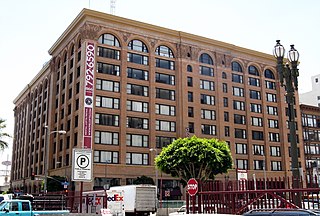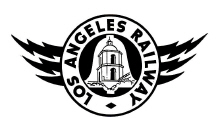
The Pacific Electric Railway Company, nicknamed the Red Cars, was a privately owned mass transit system in Southern California consisting of electrically powered streetcars, interurban cars, and buses and was the largest electric railway system in the world in the 1920s. Organized around the city centers of Los Angeles and San Bernardino, it connected cities in Los Angeles County, Orange County, San Bernardino County and Riverside County.

The Port of Los Angeles is a seaport managed by the Los Angeles Harbor Department, a unit of the City of Los Angeles. It occupies 7,500 acres (3,000 ha) of land and water with 43 miles (69 km) of waterfront and adjoins the separate Port of Long Beach. Promoted as "America's Port", the port is located in San Pedro Bay in the San Pedro and Wilmington neighborhoods of Los Angeles, approximately 20 miles (32 km) south of downtown.

Terminal Island, historically known as Isla Raza de Buena Gente, is a largely artificial island located in Los Angeles County, California, between the neighborhoods of Wilmington and San Pedro in the city of Los Angeles, and the city of Long Beach. Terminal Island is roughly split between the Port of Los Angeles and Port of Long Beach. Land use on the island is entirely industrial and port-related except for Federal Correctional Institution, Terminal Island.

USS Lamberton (DD-119)/(DMS-2) was a Wickes-class destroyer in the United States Navy in commission from 1918 to 1922 and from 1930 to 1946. She saw service during World War II. She was the only ship named for Benjamin P. Lamberton, a rear admiral who served with Admiral Dewey in the Battle of Manila Bay in 1898 during the Spanish–American War.

The New York and Atlantic Railway (NY&A) is a short line railroad on Long Island, within the southeastern portion of the U.S. state of New York. It was formed in 1997 to provide freight service over the tracks of the Long Island Rail Road, a public commuter rail agency which had decided to privatize its freight operations. A subsidiary of the Anacostia Rail Holdings Company, NY&A operates exclusively on Long Island and is connected to the U.S. mainland via CSX's Fremont Secondary over the Hell Gate Bridge. It also interchanges with New York New Jersey Rail's car float at the 65th Street Yard and US Rail of New York in Yaphank, New York. Its primary freight yard is Fresh Pond Junction in Queens. It has another yard, Pine Aire Yard, in northern Bay Shore, New York. The NY&A officially took over Long Island Rail Road's freight operations on May 11, 1997, with an initial franchise for 20 years.

San Pedro Bay is an inlet on the Pacific Ocean coast of southern California, United States. It is the site of the Port of Los Angeles and the Port of Long Beach, which together form the fifth-busiest port facility in the world and the busiest in the Americas. The Los Angeles community of San Pedro borders a small portion of the western side of the bay. The city of Long Beach borders the port on the eastern side of the bay. The northern part of the bay, which is the largest part of the port, is bordered by the Los Angeles neighborhood of Wilmington.

New York New Jersey Rail, LLC is a switching and terminal railroad that operates the only car float operation across Upper New York Bay between Jersey City, New Jersey and Brooklyn, New York. Since mid-November 2008, it has been owned by the Port Authority of New York and New Jersey, which acquired it for about $16 million as a step in a process that might see a Cross-Harbor Rail Tunnel completed.

The historic Pacific Electric Building, opened in 1905 in the core of Los Angeles as the main train station for the Pacific Electric Railway, as well as the company's headquarters; Main Street Station served passengers boarding trains for the south and east of Southern California. The building was designed by architect Thornton Fitzhugh. Though not the tallest in Los Angeles, its ten floors enclosed the greatest number of square feet in any building west of Chicago for many decades. Above the train station, covering the lower floors, were five floors of offices; and in the top three was the Jonathan Club, one of the city's leading businessmen's clubs introduced by magnates from the Northeast. After the “Great Merger” of Pacific Electric into Southern Pacific Railroad in 1911, the PE Building became the home of Southern Pacific in Los Angeles. In 1925, a second electric rail hub, the Subway Terminal, was opened near Pershing Square to serve the north and west.

The Los Angeles Railway was a system of streetcars that operated in Central Los Angeles and surrounding neighborhoods between 1895 and 1963. The system provided frequent local services which complemented the Pacific Electric "Red Car" system's largely commuter-based interurban routes. The company carried many more passengers than the Red Cars, which served a larger and sparser area of Los Angeles.

The Pacific Harbor Line was formed in 1998 to take over the Harbor Belt Line (HBL). In 1998, the Alameda Corridor was nearing completion, allowing for a massive amount of railroad traffic from the largest harbors in the Western hemisphere: Port of Los Angeles and Port of Long Beach.

The MV Illahee was a Steel Electric-class ferry operated by Washington State Ferries.

USS Sturtevant (DE-239) was an Edsall class destroyer escort in service with the United States Navy from 1943 to 1946 and from 1951 to 1960. She was scrapped in 1973.

USS Caelum (AK-106) was a Crater-class cargo ship commissioned by the US Navy for service in World War II. Caelum was named after the constellation Caelum. She was responsible for delivering troops, goods and equipment to locations in the Asiatic-Pacific Theater.

Sims Limited (formerly Sims Metal Management Limited) is a global environmental services conglomerate, operating through a number of divisions, with a focus on: (a) Ferrous and Non-ferrous metal recycling, (b) enterprise data destruction and cloud asset management (c) post-consumer electronic goods recycling and reuse, (d) municipal waste recycling, (e) gas to energy, and (f) waste to energy. Founded in 1917, its primary operations are located in the United States, Australia and the UK.

The Port of Los Angeles Waterfront Red Car Line was a 1.5-mile (2.4 km) heritage streetcar line for public transit along the waterfront in San Pedro, at the Port of Los Angeles in Los Angeles, California. The line operated between July 2003 and September 2015, when service was discontinued due to major construction projects that resulted in the demolition of a portion of the route.

San Pedro via Dominguez was a 25.39-mile (40.86 km) interurban transport route, part of the Pacific Electric system in Greater Los Angeles. Its termini were the Pacific Electric Building in Downtown Los Angeles and San Pedro in the south.
USS PC-1230 was a Patrol Craft, laid down in 1942, participating in escort and convoy missions in the Pacific in World War II, and performed harbor control duties during the Battle of Peleliu.

California during World War II was a major contributor to the World War II effort. California's long Pacific Ocean coastline provided the support needed for the Pacific War. California also supported the war in Europe. After the Japanese attack on Pearl Harbor on December 7, 1941, most of California's manufacturing was shifted to the war effort. California became a major ship builder and aircraft manufacturer. Existing military installations were enlarged and many new ones were built. California trained many of the troops before their oversea deployment. Over 800,000 Californians served in the United States Armed Forces. California agriculture, ranches and farms were used to feed the troops around the world. California's long coastline also put the state in fear, as an attack on California seemed likely. California was used for the temporary and permanent internment camps for Japanese Americans. The population grew significantly, largely due to servicemen who were stationed at the new military bases/training facilities and the mass influx of workers from around the U.S. in the growing defense industries. With all the new economy activity, California was lifted out of the Great Depression. Over 500,000 people moved to California from other states to work in the growing economy. California expanded its oil and mineral production to keep up with the war demand.

Naval Operating Base Terminal Island, was United States Navy base founded on 25 September 1941 to support the World War II efforts in the Pacific War. Naval Operating Base Terminal Island was founded by combining Naval Facilities in cities of San Pedro, Long Beach and Wilmington, California under one command. Much of the base was on the man-made Terminal Island, and harbor in San Pedro Bay. The harbor was made through the construction of a large breakwater system.

San Pedro featured a network of streetcars between 1903 and 1958. The establishment of the Port of Los Angeles in the early 1900s spurred the development of the nearby city, and electric streetcars provided local transit services for workers and later military personnel. Pacific Electric was the primary operator in the city.


















